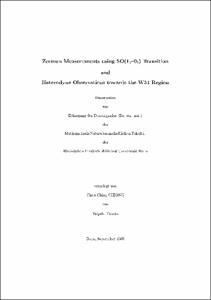Chiong, Chau Ching: Zeeman Measurements using SO (10-01) Transition and Heterodyne Observations towards the W51 Region. - Bonn, 2003. - Dissertation, Rheinische Friedrich-Wilhelms-Universität Bonn.
Online-Ausgabe in bonndoc: https://nbn-resolving.org/urn:nbn:de:hbz:5n-02973
Online-Ausgabe in bonndoc: https://nbn-resolving.org/urn:nbn:de:hbz:5n-02973
@phdthesis{handle:20.500.11811/1955,
urn: https://nbn-resolving.org/urn:nbn:de:hbz:5n-02973,
author = {{Chau Ching Chiong}},
title = {Zeeman Measurements using SO (10-01) Transition and Heterodyne Observations towards the W51 Region},
school = {Rheinische Friedrich-Wilhelms-Universität Bonn},
year = 2003,
note = {Understanding the star-forming procedure is one of the most important topic in astrophysics. One of the most unexplored fields in the star-forming theories is magnetic field. Magnetic field is believed to play an important role in regulating the rate of star formation. Among various means of measurements, Zeeman effect is the only direct way to measure the magnetic field strength in the interstellar medium. In the first part of the thesis, Zeeman measurements using the SO(10-01) transition is chosen to probe magnetic fields towards the dense region. To my knowledge, this is the first attempt to measure the Zeeman effect with this transition. With the latest microwave technology, we set up a receiver aiming at the Zeeman observation with this specific transition. The theories and complete procedure, including the preparatory works, the instrumentation, the difficulties in the measurements, and the data reduction are described in detail in the thesis. Though we detect the magnetic field strength of - 2.1 ± 1.5 mG (3σ) after 45.5 hours integration towards DR21(OH) region, we cannot identify the originating cloud of the field. Towards the Orion B region, we can only derive the upper limit.
Magnetic fields can regulate the star formation rate via ambipolar diffusion. This procedure separates the ionized and neutral materials in the interstellar medium. The study of the photodissociation regions (PDRs) is thus another important topic to understand the star formation. In the latter part of the thesis, the CO(4-3) and CI(3P1-3P0) data of the massive star-forming region W51 using the CHAMP array receiver at the CSO is presented. We separated the complex structure into at least four velocity components. The CO(4-3) line is highly optically thick. Towards the W51d dense region, the kinetic temperature is constrained between 65 to 80 K and CO column density between 1 to 2.5 x 1019 cm-2 using the LVG approximation for the density range of n(H2) = 104 to 105 cm-3. The correlation of CI and 13CO is not as striking as other cases. Strong CI emission is found even deep in the cloud cores. It cannot be explained by a single parallel layer PDR model, therefore a time-dependent chemistry model is introduced. The W51 region provides a precious example for the study of PDRs with large areas and large ranges of intensity.},
url = {https://hdl.handle.net/20.500.11811/1955}
}
urn: https://nbn-resolving.org/urn:nbn:de:hbz:5n-02973,
author = {{Chau Ching Chiong}},
title = {Zeeman Measurements using SO (10-01) Transition and Heterodyne Observations towards the W51 Region},
school = {Rheinische Friedrich-Wilhelms-Universität Bonn},
year = 2003,
note = {Understanding the star-forming procedure is one of the most important topic in astrophysics. One of the most unexplored fields in the star-forming theories is magnetic field. Magnetic field is believed to play an important role in regulating the rate of star formation. Among various means of measurements, Zeeman effect is the only direct way to measure the magnetic field strength in the interstellar medium. In the first part of the thesis, Zeeman measurements using the SO(10-01) transition is chosen to probe magnetic fields towards the dense region. To my knowledge, this is the first attempt to measure the Zeeman effect with this transition. With the latest microwave technology, we set up a receiver aiming at the Zeeman observation with this specific transition. The theories and complete procedure, including the preparatory works, the instrumentation, the difficulties in the measurements, and the data reduction are described in detail in the thesis. Though we detect the magnetic field strength of - 2.1 ± 1.5 mG (3σ) after 45.5 hours integration towards DR21(OH) region, we cannot identify the originating cloud of the field. Towards the Orion B region, we can only derive the upper limit.
Magnetic fields can regulate the star formation rate via ambipolar diffusion. This procedure separates the ionized and neutral materials in the interstellar medium. The study of the photodissociation regions (PDRs) is thus another important topic to understand the star formation. In the latter part of the thesis, the CO(4-3) and CI(3P1-3P0) data of the massive star-forming region W51 using the CHAMP array receiver at the CSO is presented. We separated the complex structure into at least four velocity components. The CO(4-3) line is highly optically thick. Towards the W51d dense region, the kinetic temperature is constrained between 65 to 80 K and CO column density between 1 to 2.5 x 1019 cm-2 using the LVG approximation for the density range of n(H2) = 104 to 105 cm-3. The correlation of CI and 13CO is not as striking as other cases. Strong CI emission is found even deep in the cloud cores. It cannot be explained by a single parallel layer PDR model, therefore a time-dependent chemistry model is introduced. The W51 region provides a precious example for the study of PDRs with large areas and large ranges of intensity.},
url = {https://hdl.handle.net/20.500.11811/1955}
}






